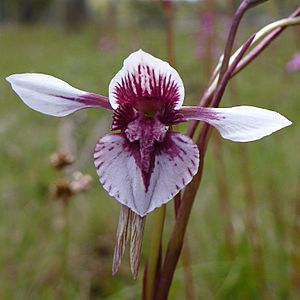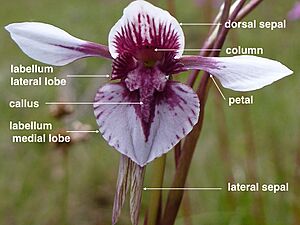Veined doubletail facts for kids
Quick facts for kids Veined doubletail |
|
|---|---|
 |
|
| Diuris venosa growing in Barrington Tops National Park | |
| Conservation status | |
| Scientific classification | |
| Genus: |
Diuris
|
| Species: |
venosa
|
The Diuris venosa, also known as the veined doubletail, is a special type of orchid. It only grows in New South Wales, Australia. This beautiful plant has a few thin, upright leaves. It produces up to four flowers that can be white or light purple. These flowers often have cool deep red or purple spots and lines.
Contents
What Does the Veined Doubletail Look Like?
The veined doubletail orchid grows from a tuber, which is like a small underground storage part. It's a perennial plant, meaning it lives for more than two years. This orchid is a terrestrial herb, so it grows on land and has soft stems.
It has three to five thin, thread-like leaves. These leaves stand upright and are about 5 to 12 centimeters (2-5 inches) long. They are also quite narrow, only 1 to 3 millimeters (0.04-0.1 inches) wide.
The orchid can have up to four flowers on a tall stem called a raceme. This stem can be 10 to 40 centimeters (4-16 inches) high. Each flower is about 25 millimeters (1 inch) wide. The flowers are white or light purple. They have many purple lines and blotches, which makes them look unique.
The top part of the flower, called the dorsal sepal, is shaped like a wide egg. It's about 9 to 12 millimeters (0.35-0.47 inches) long. This sepal forms a small hood over the flower's center, called the column. The two side sepals hang down below the flower. They are long and narrow, about 11 to 18 millimeters (0.43-0.7 inches) long.
The petals of the flower are shaped like narrow eggs. They are 3 to 10 millimeters (0.1-0.4 inches) long. These petals spread out sideways and look a bit like cow's ears. The labellum is a special lip-like part of the flower. It is 10 to 13 millimeters (0.4-0.5 inches) long and has three parts, called lobes. The side lobes are narrow with a wavy edge. The middle lobe is wide and almost round.
How Did It Get Its Name?
The Diuris venosa was first officially described in 1926. This was done by a person named Herman Rupp. He published his description in a science magazine called Victorian Naturalist.
The second part of its scientific name, venosa, comes from a Latin word. This word means "veiny," which describes the many lines and blotches on the orchid's flowers.
Where Does It Live?
This special orchid is only found in New South Wales, Australia. You can see it growing in places like the Barrington Tops and New England National Parks. It likes to grow in wet, grassy areas, often in swamps.
Why Is It Special? (Conservation)
The Diuris venosa is listed as "Vulnerable" by the Australian Government. This means it needs protection because its numbers are decreasing. It's protected under a law called the Environment Protection and Biodiversity Conservation Act 1999.
Some things that threaten this orchid's survival include:
- Weeds: Other plants, especially an introduced weed called English broom (Cytisus scoparius), can grow too much and take over the orchid's habitat.
- Plant Removal: Sometimes, people illegally remove these plants from their natural homes.
- Animals: Wild pigs (Sus scrofa) can eat or damage the plants.



